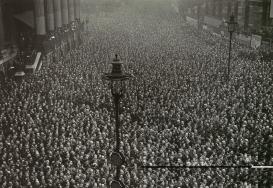My project is a contribution to the history of listening techniques. It compares practices of listening in the minute’s silence, as they were programmed, established, performed, and commented on in commemoration ceremonies for the war dead in the years after 1919, with reflections on listening in theoretical work on radio in the mid-1920s. There is a link between these two, hinting at the ways in which new acoustic media and technologies are preceded and conditioned by practices from seemingly distant fields of culture.
As a political staging, the minute’s silence conjured up an acoustically synchronized, often national community that listened to the same sound at the same moment. In this respect, it anticipated the listening experiences enabled by radio, which were to spread soon after the minute’s silence became established in memorial cultures throughout Europe. Both sets of listening practices featured a huge, acoustically connected crowd, dispersed over a large territory and simultaneously listening to the same sound. However, the links go beyond phenomenological similarities. Descriptions of listening experiences in the minute’s silence often note that silence affected the participants’ perception and consciousness, resulting in the enhancement of attentiveness, auditory awareness, or capacity for remembering. These effects are also at the center of reflections in early radio theory. After the first enthusiasm for radio as a powerful device to infiltrate and link people’s minds by means of a unified sound object, radio theory turned towards the listening subjects and the social heterogeneity, subjectivity, and situatedness of their practices. While radio was horrified by silence on air (especially in its early years), the minute’s silence enabled highly subjective, imaginative, and heterogeneous forms of listening—exactly the kind of sound object that radio theory was desperately seeking.

